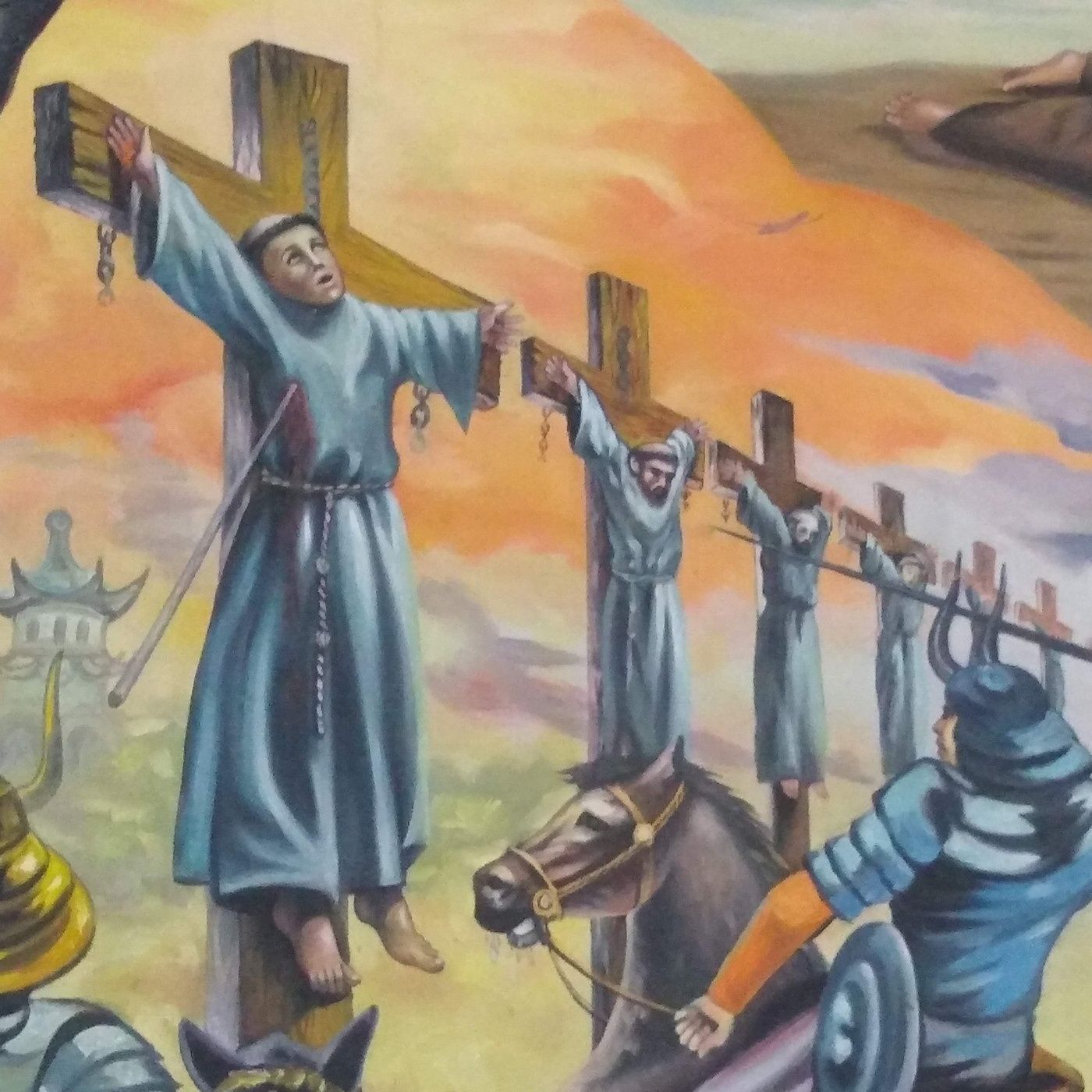
February 6: Saint Paul Miki and Companions, Martyrs
 2024-02-05
2024-02-05
Download
Right click and do "save link as"
February 6: Saint Paul Miki and Companions, Martyrs
St. Paul Miki: c. 1562–1597; Late Sixteenth Century
Memorial; Liturgical Color: Red
(When Lenten Weekday, Optional Memorial; Violet)
Patron Saints of Japan
Native Japanese die to gain the pearl of great price
The words of the American poet John Greenleaf Whittier capture the pathos of today’s memorial: “For of all sad words of tongue or pen, The saddest are these: ‘It might have been!’” The swift rise, and sudden fall, of Catholicism in Japan is one of the great “might-have-beens” in human history. Portuguese and Spanish priests, mostly Jesuits and Franciscans, brought the Catholic religion to the highly cultured island of Japan in the late 1500s with great success. Tens of thousands of people converted, two seminaries were opened, native Japanese were ordained as priests, and Japan ceased to be mission territory, being elevated to a diocese. But the rising arc of missionary success just as quickly curved downward. In waves of persecutions from the 1590s through the 1640s, thousands of Catholics were persecuted, tortured, and executed until the Catholic religion, and indeed any outward expression of Christianity, was totally eradicated.
Japan almost became a Catholic nation, coming close to joining the Philippines as the only thoroughly Catholic society in Asia. Japan might have done for Asia in the 1600s what Ireland did for Europe in the early Middle Ages. It could have sent scholars, monks, and missionary priests to convert nations far larger than itself, including China. It was not to be.
Paul Miki was a native Japanese who became a Jesuit. The Jesuits would not accept into their seminary men from India or other nations who they felt were of inferior education. But the Jesuits had immense respect for the Japanese, whose culture was equal to, or even exceeded, that of Western Europe. Paul Miki was among those who, after being educated in the faith, evangelized their own people in their own language. He and others blazed a new pathway forward, allowing the Japanese to not only understand but to see, in flesh and blood, that they could retain the best of their native culture while being faithful to the newfound God of Jesus Christ.
Paul, a Jesuit brother, and his companions were the first group to suffer mass martyrdom in Japan. A military leader and adviser to the Emperor feared Spanish and Portuguese conquest of the island and ordered the arrest of six Franciscan priests and brothers, three Japanese Jesuits, sixteen other Japanese, and one Korean. The captured had their left ears mutilated and were then forced to march, bloodied, hundreds of miles to Nagasaki. On February 5, 1597, Paul and his companions were bound to crosses on a hill, like Christ, and pierced with lances. An eyewitness described the scene: “Our brother, Paul Miki, saw himself standing in the noblest pulpit he had ever filled. To his “congregation” he began by proclaiming himself a Japanese and a Jesuit... ‘My religion teaches me to pardon my enemies and all who have offended me. I do gladly pardon the Emperor and all who have sought my death. I beg them to seek baptism and be Christians themselves.’ Then he looked at his comrades and began to encourage them in their final struggle...Then, according to Japanese custom, the four executioners began to unsheathe their spears…The executioners killed them one by one. One thrust of the spear, then a second blow. It was over in a short time.”
The executions did nothing to stop the Church. Persecution only fanned the flames of faith. By 1614 about 300,000 Japanese were Catholics. More intense persecutions followed until Japan’s leaders sealed off their ports and borders from virtually all foreign penetration, a policy that lasted until the nineteenth century. Only in 1854 was Japan forcibly opened to foreign trade and Western visitors. Then, thousands of Japanese Catholics suddenly came out of hiding, mostly near Nagasaki. They bore the names of the Japanese martyrs, spoke some Latin and Portuguese, asked their new guests for statues of Jesus and Mary, and sought to verify if a French priest was legitimate with two questions: 1) Are you celibate?; and 2) Do you come from the Pope in Rome? These hidden Christians also opened their fists to show the priest something else—relics of the martyrs who their remote ancestors had honored centuries before. Their memory had never died.
Saint Paul Miki, you accepted martyrdom rather than abandon your faith. You chose to serve those closest to you rather than to flee. May we too know, love, and serve God in the heroic fashion that made you so brave and composed in the face of intense suffering.
view more
St. Paul Miki: c. 1562–1597; Late Sixteenth Century
Memorial; Liturgical Color: Red
(When Lenten Weekday, Optional Memorial; Violet)
Patron Saints of Japan
Native Japanese die to gain the pearl of great price
The words of the American poet John Greenleaf Whittier capture the pathos of today’s memorial: “For of all sad words of tongue or pen, The saddest are these: ‘It might have been!’” The swift rise, and sudden fall, of Catholicism in Japan is one of the great “might-have-beens” in human history. Portuguese and Spanish priests, mostly Jesuits and Franciscans, brought the Catholic religion to the highly cultured island of Japan in the late 1500s with great success. Tens of thousands of people converted, two seminaries were opened, native Japanese were ordained as priests, and Japan ceased to be mission territory, being elevated to a diocese. But the rising arc of missionary success just as quickly curved downward. In waves of persecutions from the 1590s through the 1640s, thousands of Catholics were persecuted, tortured, and executed until the Catholic religion, and indeed any outward expression of Christianity, was totally eradicated.
Japan almost became a Catholic nation, coming close to joining the Philippines as the only thoroughly Catholic society in Asia. Japan might have done for Asia in the 1600s what Ireland did for Europe in the early Middle Ages. It could have sent scholars, monks, and missionary priests to convert nations far larger than itself, including China. It was not to be.
Paul Miki was a native Japanese who became a Jesuit. The Jesuits would not accept into their seminary men from India or other nations who they felt were of inferior education. But the Jesuits had immense respect for the Japanese, whose culture was equal to, or even exceeded, that of Western Europe. Paul Miki was among those who, after being educated in the faith, evangelized their own people in their own language. He and others blazed a new pathway forward, allowing the Japanese to not only understand but to see, in flesh and blood, that they could retain the best of their native culture while being faithful to the newfound God of Jesus Christ.
Paul, a Jesuit brother, and his companions were the first group to suffer mass martyrdom in Japan. A military leader and adviser to the Emperor feared Spanish and Portuguese conquest of the island and ordered the arrest of six Franciscan priests and brothers, three Japanese Jesuits, sixteen other Japanese, and one Korean. The captured had their left ears mutilated and were then forced to march, bloodied, hundreds of miles to Nagasaki. On February 5, 1597, Paul and his companions were bound to crosses on a hill, like Christ, and pierced with lances. An eyewitness described the scene: “Our brother, Paul Miki, saw himself standing in the noblest pulpit he had ever filled. To his “congregation” he began by proclaiming himself a Japanese and a Jesuit... ‘My religion teaches me to pardon my enemies and all who have offended me. I do gladly pardon the Emperor and all who have sought my death. I beg them to seek baptism and be Christians themselves.’ Then he looked at his comrades and began to encourage them in their final struggle...Then, according to Japanese custom, the four executioners began to unsheathe their spears…The executioners killed them one by one. One thrust of the spear, then a second blow. It was over in a short time.”
The executions did nothing to stop the Church. Persecution only fanned the flames of faith. By 1614 about 300,000 Japanese were Catholics. More intense persecutions followed until Japan’s leaders sealed off their ports and borders from virtually all foreign penetration, a policy that lasted until the nineteenth century. Only in 1854 was Japan forcibly opened to foreign trade and Western visitors. Then, thousands of Japanese Catholics suddenly came out of hiding, mostly near Nagasaki. They bore the names of the Japanese martyrs, spoke some Latin and Portuguese, asked their new guests for statues of Jesus and Mary, and sought to verify if a French priest was legitimate with two questions: 1) Are you celibate?; and 2) Do you come from the Pope in Rome? These hidden Christians also opened their fists to show the priest something else—relics of the martyrs who their remote ancestors had honored centuries before. Their memory had never died.
Saint Paul Miki, you accepted martyrdom rather than abandon your faith. You chose to serve those closest to you rather than to flee. May we too know, love, and serve God in the heroic fashion that made you so brave and composed in the face of intense suffering.
More Episodes
September 16: Saint Cornelius, Pope, Martyr
 2024-09-16
2024-09-16
 2024-09-16
2024-09-16
September 16: Saint Cyprian, Bishop, Martyr
 2024-09-15
2024-09-15
 2024-09-15
2024-09-15
September 15: Our Lady of Sorrows
 2024-09-14
2024-09-14
 2024-09-14
2024-09-14
September 14: Exaltation of the Holy Cross
 2024-09-14
2024-09-14
 2024-09-14
2024-09-14
August 27: Saint Monica
 2024-08-26
2024-08-26
 2024-08-26
2024-08-26
August 25: Saint Louis
 2024-08-25
2024-08-25
 2024-08-25
2024-08-25
August 25: Saint Joseph Calasanz, Priest
 2024-08-25
2024-08-25
 2024-08-25
2024-08-25
August 24: Saint Bartholomew, Apostle
 2024-08-24
2024-08-24
 2024-08-24
2024-08-24
012345678910111213141516171819
Create your
podcast in
minutes
- Full-featured podcast site
- Unlimited storage and bandwidth
- Comprehensive podcast stats
- Distribute to Apple Podcasts, Spotify, and more
- Make money with your podcast
It is Free
- Privacy Policy
- Cookie Policy
- Terms of Use
- Consent Preferences
- Copyright © 2015-2024 Podbean.com





